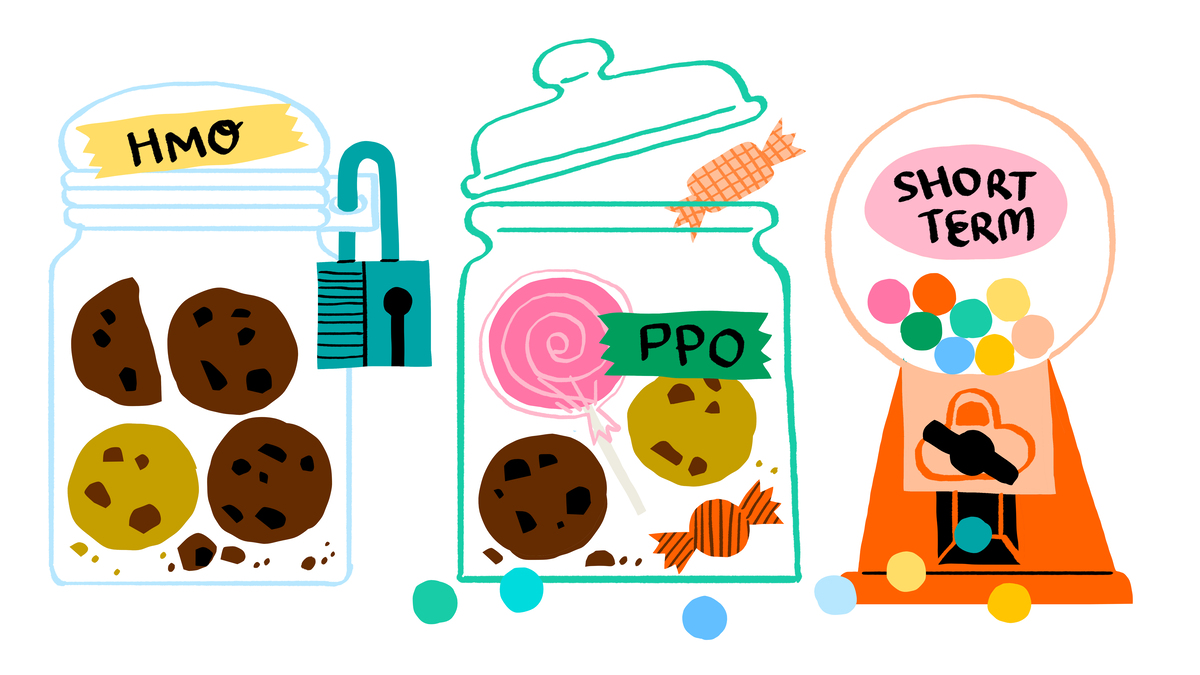

Do you ever feel like health insurance is confusing on purpose? There is so much jargon and so many acronyms. It’s tempting to just close your eyes and point at a plan, hoping that it’s in your budget and covers the stuff you’ll need it for.
But putting in a bit of time to learn what these health insurance terms mean can empower you to better understand what signing on to a plan might mean for your budget and your health.
Now’s the time to get in there because fall is open enrollment season. Whether you’re picking a plan for the first time, you’re in a plan that doesn’t work for you, or you’re uninsured and want to see if you have any workable options — this is your chance to sign up for a plan.
(For more tips on finding a health insurance plan, listen to the audio at the top of the page.)
Where to find coverage


The first piece of advice is this: Don’t do an online search for “I need health insurance” and expect the internet to help you out. That’s an easy way to end up on sketchy websites or bombarded with ads and phone calls. Instead, figure out where to go — based on your age, job, income — and go straight there to find a plan.
Medicare: If you’re 65 or older, you’re eligible for Medicare. It’s a federally run program — the government pays for your health care. You might also be eligible even if you’re not yet 65 if you have certain disabilities or conditions like kidney failure.
Medicaid: Medicaid is a health insurance program for people with low incomes, and others with certain disabilities. It covers around 80 million people — nearly one in four Americans. It’s funded by both the federal and state governments but run by the state, so whether you’re eligible depends on which state you live in. You can apply for Medicaid coverage at any time, all year round, and Healthcare.gov will help you figure out if you qualify and where to apply in your state.
CHIP: CHIP stands for Children’s Health Insurance Program and provides affordable coverage for kids in low-income families. In some states, it’s part of the state’s Medicaid program, and in some states, it’s a standalone program. Children might be eligible for CHIP even if their parents don’t qualify for Medicaid. Routine doctor and dental checkups are free under CHIP. Like Medicaid, you can apply for coverage any time, all year round. Look here to find out what CHIP and Medicaid are called in your state, and find how to apply at Healthcare.gov.

Employer: Almost half of all Americans get their health insurance as a benefit through their job. (The reason behind this is kind of a strange and crazy story that goes back to World War II, outlined beautifully in this episode of NPR’s Throughline). These are private group health insurance plans, and your employer usually pays most of your monthly premium.
Affordable Care Act Marketplaces: For practically everyone else, the place to go is Healthcare.gov, where you can shop for insurance in the marketplaces created by the Affordable Care Act. If you hear “health insurance marketplace” or “insurance exchange” or “Obamacare insurance” — they’re all the same thing. They refer to the online shopping tools you can use at the federal marketplace website, Healthcare.gov, or through one set up and operated by state. Some states run their marketplaces, like Your Health Idaho or DC Health Link. (If you live in one of these states, not to fear, starting at Healthcare.gov will still get you the right place.) The number of plans you have to choose from and how expensive they are will vary a lot, depending on your income and where you live.
Other options: If you’re a veteran, you can get health coverage through the Veterans Health Administration. If you are a tribal member, you may have options through the Indian Health Service. If you’re in college, you can choose from student health plans (though be careful — health plans based at the college are usually quite limited) or you can stay on your parents’ plan as long as you’re not 26 or older.
And if you’ve lost a job that offered you health insurance, you may be able to keep your old plan through COBRA, although you’ll be paying a much higher premium since your company won’t be chipping in (if you’re eligible, you should get information from your insurer or employer on how to sign up).
Types of plans


Not all plans are created equal. Some plans are more flexible than others, and some plans look like great deals but are actually skimpy.
HMO or Health Maintenance Organization: An HMO tends to have a strict network of doctors and other health care providers — if you see a provider in the network, you’re good, but if you go outside of the network, the costs are all on you, except in certain emergency situations.
PPO or Preferred Provider Organization: A PPO still has a network of providers, but if you see out-of-network providers, your insurance will still cover some of the costs.
Short-term or “Limited Duration” plans: You have to be super careful about this. Some of the health insurance plans people might try to sell you are “short term” or “skinny” plans. They might seem very appealing because they’re cheap, but they also might not cover some basic things like prescription drugs and annual checkups. That’s why a lot of experts warn that — beyond use for a few weeks or months between school and a job, for instance — they’re not a very good deal.
Learn those tricky cost terms


To compare plans and figure out which one might work best for you, you need to learn your health insurance vocab. Otherwise, it’s just a smorgasbord of (nerve-wracking-ly high) dollar figures.
Premium: The premium is the amount you pay every month. It’s just like your internet subscription or any other bill — pretty straightforward. If you’re buying insurance on Healthcare.gov, you might get discounts on your premium costs, depending on your income, where you live, and who’s in your household, so always shop for plans after you’ve entered that information. Millions of uninsured people qualify for zero-dollar premium plans — and even more people qualify for plans with premiums of $10 or less per month.

Cost-sharing: “Cost-sharing” is an umbrella term — it’s your share of the costs for health care services you receive. It comes in several forms: the deductible, co-payments, and coinsurance. While you pay your premium every month no matter what, these other payments only come into play when you pick up a prescription or see a doctor or other provider, or have some sort of exam or procedure done.”
Deductible: Your deductible is a threshold — it’s the amount of money that you have to spend on health services before your insurance starts paying. At the beginning of every year, your deductible resets to zero, so the first appointments and prescriptions you pick up in the year might seem extra expensive because you haven’t hit your deductible yet. Your insurance company is waiting, and when you hit that magic number, it’ll sit up and start kicking in.

Copayment and Coinsurance After you hit your deductible, you’ll likely still have some costs when you go to the doctor, in the form of a copayment (a fixed amount) or coinsurance (your percentage of the total cost).
Out-of-pocket maximum All this cost-sharing does have a limit. If you end up using a lot of health insurance in a single year, you might hit your out-of-pocket maximum, which is the most you’ll ever have to pay on covered health services in a given year. It’s the threshold above the deductible — if you hit it, you’ll have no copays or coinsurance — your insurance will pay 100{6f90f2fe98827f97fd05e0011472e53c8890931f9d0d5714295052b72b9b5161} of the cost of all covered health services for the rest of that calendar year.
How much coverage do you need?


Now, presumably, you’re in the right place; you’re starting to see different options and figure out what might fit in your budget. Maybe you’re picking from one or two options through work — if so, you might just ask your co-workers what they like and call it a day.

If you have a lot of options and need to narrow it down, think about what’s predictable about your health to guide you — for instance, the particular doctors or specialists you want to see, prescriptions you know you’ll be picking up, and ongoing conditions you need to manage. If you need dental or vision care, check to see if your plan includes those things or if you’ll have to buy that sort of insurance separately.
Also — rest assured that any health plan you pick through work or the federal or state marketplaces set up through the Affordable Care Act will cover the ACA’s 10 essential benefits — such as free preventive care and hospital coverage.
Basic or catastrophic: If you’re pretty healthy — no chronic medical conditions, or need to take pricey prescription drugs — a basic plan might be all you need. It’ll provide financial protection if you get a serious diagnosis or get into an accident, and you’ll otherwise only need to worry about — hopefully affordable — premiums. Under the “metal categories” on Healthcare.gov, these are the bronze plans.

Medium coverage: If you do have specialists you know you need to see or other ongoing health issues, you might want to look at the plans that may have higher premiums, but offer more coverage. On Healthcare.gov you can enter the names of your prescriptions or doctors you know you’ll need to see to filter out plans that don’t include those medicines or people. These are the silver plans on the marketplaces, and they sometimes come with extra discounts. If you’re getting a plan through work or elsewhere and you can’t easily filter plan options, you can always call the insurance company and ask: “Is my doctor (or preferred hospital or other health care provider) in-network for this plan?” “Is my medicine on the plan’s formulary (the list of medications an insurance plan will cover)?”
Comprehensive coverage: Say you have a bigger budget for monthly premiums and you want to pay more every month to have access to more flexibility and lower copays — a comprehensive plan might be your best bet. These are gold or platinum plans on Healthcare.gov. You can use the same tips to make sure the plans will cover what you need — filter for your regular doctors or prescriptions, or — when in doubt — call the insurance company and make sure the plan you’re considering will be there when you need it.
The audio portion of this episode was produced by Janet W. Lee, with engineering support from Joshua Newell.
We’d love to hear from you. If you have a good life hack, leave us a voicemail at 202-216-9823, or email us at [email protected]. Your tip could appear in an upcoming episode.
If you love Life Kit and want more, subscribe to our newsletter.






More Stories
The Introvert’s Sanctuary: Why Creating a Home Gym Could Transform Your Wellbeing
Health and Fitness: A Holistic Approach
10 killer 10-minute workouts to transform your fitness routine